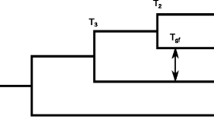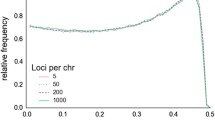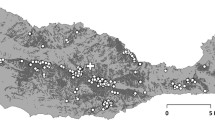Abstract
Statistical power is critical in conservation for detecting genetic differences in space or time from allele frequency data. Organelle and nuclear genetic markers have fundamentally different transmission dynamics; the potential effect of these differences on power to detect divergence have been speculated on but not investigated. We examine, analytically and with computer simulations, the relative performance of organelle and nuclear markers under basic, ideal situations. We conclude that claims of a generally higher resolving power of either marker type are not correct. The ratio R = F ST,organelle/F ST,nuclear varies between 1 and 4 during differentiation and this greatly affects the power relationship. When nuclear F ST is associated with organelle differentiation four times higher, the power of the organelle marker is similar to two nuclear loci with the same allele frequency distribution. With large sample sizes (n ≥ 50) and several populations or many alleles per locus (≥5), the power difference may typically be disregarded when nuclear F ST > 0.05. To correctly interpret observed patterns of genetic differentiation in practical situations, the expected F STs and the statistical properties (i.e., power analysis) of the genetic markers used should be evaluated, taking the observed allele frequency distributions into consideration.



Similar content being viewed by others
References
Allendorf FW, Luikart G (2007) Conservation and the genetics of populations. Blackwell Publishing, Malden, Massachusetts
Angers B, Bernatchez L (1998) Combined use of SMM and non-SMM methods to infer fine structure and evolutionary history of closely related brook charr (Salvelinus fontinalis, Salmonidae) populations from microsatellites. Mol Biol Evol 15:143–159
Arnaud-Haond S, Bonhomme F, Blanc F (2003) Large discrepancies in differentiation of allozymes, nuclear and mitochondrial DNA loci in recently founded Pacific populations of pearl oyster Pinctada margaritifera. J Evol Biol 16:388–398. doi:10.1046/j.1420-9101.2003.00549.x
Avise JC (2004) Molecular markers, natural history, and evolution, 2nd edn. Sinauer Associates, Inc. Publishers, Sunderland, Massachusetts
Bamshad M, Fraley AE, Crawford MH et al (1996) mtDNA variation in caste populations of Andhra Pradesh, India. Hum Biol 68:1–28
Birky CW Jr, Maruyama T, Fuerst P (1983) An approach to population and evolutionary genetic theory for genes in mitochondria and chloroplasts, and some results. Genetics 103:513–527
Birky CW Jr, Fuerst P, Maruyama T (1989) Organelle gene diversity under migration, mutation, and drift-equilibrium expectations, approach to equilibrium, effects of heteroplasmic cells, and comparison to nuclear genes. Genetics 121:613–627
Bowen BW, Bass AL, Soares L et al (2005) Conservation implications of complex population structure: lessons from the loggerhead turtle (Caretta caretta). Mol Ecol 14:2389–2402. doi:10.1111/j.1365-294X.2005.02598.x
Crochet PA (2000) Genetic structure of avian populations—allozymes revisited. Mol Ecol 9:1463–1469. doi:10.1046/j.1365-294x.2000.01026.x
Crow JF, Kimura M (1970) An introduction to population genetics theory. Alpha Editions, Minneapolis, MN
Dizon AE, Taylor BL, O’Corry-Crowe GM (1995) Why statistical power is necessary to link analyses of molecular variation to decisions about population structure. Am Fish Soc Symp 17:288–294
Escorza-Treviño S, Dizon AE (2000) Phylogeography, intraspecific structure and sex-biased dispersal of Dall’s porpoise, Phocoenoides dalli, revealed by mitochondrial and microsatellite DNA analyses. Mol Ecol 9:1049–1060. doi:10.1046/j.1365-294x.2000.00959.x
Geffen E, Waidyaratne S, Dalén L et al (2007) Sea ice occurrence predicts genetic isolation in the Arctic fox. Mol Ecol 16:4241–4255. doi:10.1111/j.1365-294X.2007.03507.x
Haavie J, Saetre GP, Moum T (2000) Discrepancies in population differentiation at microsatellites, mitochondrial DNA and plumage colour in the pied flycatcher—inferring evolutionary processes. Mol Ecol 9:1137–1148. doi:10.1046/j.1365-294x.2000.00988.x
Hamilton MB, Miller JR (2002) Comparing relative rates of pollen and seed gene flow in the island model using nuclear and organelle measures of population structure. Genetics 162:1897–1909
Hedrick PW (1999) Perspective: highly variable loci and their interpretation in evolution and conservation. Evolution Int J Org Evolution 53:313–318. doi:10.2307/2640768
Hedrick PW (2001) Conservation genetics: where are we now? Trends Ecol Evol 16:629–636. doi:10.1016/S0169-5347(01)02282-0
Hedrick PW (2005) A standardized genetic differentiation measure. Evolution Int J Org Evolution 59:1633–1638
Hoarau G, Piquet AMT, Van der Veer HW et al (2004) Population structure of plaice (Pleuronectes platessa L.) in northern Europe: a comparison of resolving power between microsatellites and mitochondrial DNA data. J Sea Res 51:183–190. doi:10.1016/j.seares.2003.12.002
Johnson JA, Toepfer JE, Dunn PO (2003) Contrasting patterns of mitochondrial and microsatellite population structure in fragmented populations of greater prairie-chickens. Mol Ecol 12:3335–3347. doi:10.1046/j.1365-294X.2003.02013.x
Keyser-Tracqui C, Crubézy E, Ludes B (2003) Nuclear and mitochondrial DNA analysis of a 2,000-year-old necropolis in the Egyin Gol Valley of Mongolia. Am J Hum Genet 73:247–260. doi:10.1086/377005
Laikre L, Jorde PE, Ryman N (1998) Temporal change of mitochondrial DNA haplotype frequencies and female effective size in a brown trout (Salmo trutta) population. Evolution Int J Org Evolution 52:910–915. doi:10.2307/2411286
Li W-H (1976) Effect of migration on genetic distance. Am Nat 110:841–847. doi:10.1086/283106
Liu ZJ, Cordes JF (2004) DNA marker technologies and their applications in aquaculture genetics. Aquaculture 238:1–37. doi:10.1016/j.aquaculture.2004.05.027
Nei M (1973) Analysis of gene diversity in subdivided populations. Proc Natl Acad Sci USA 70:3321–3323. doi:10.1073/pnas.70.12.3321
Nei M (1975) Molecular population genetics and evolution. North-Holland Publishing Company, Amsterdam
Nei M (1987) Molecular evolutionary genetics. Columbia University Press, New York
Nyström V, Angerbjörn A, Dalén L (2006) Genetic consequences of a demographic bottleneck in the Scandinavian arctic fox. Oikos 114:84–94. doi:10.1111/j.2006.0030-1299.14701.x
Ryman N, Jorde PE (2001) Statistical power when testing for genetic differentiation. Mol Ecol 10:2361–2373. doi:10.1046/j.0962-1083.2001.01345.x
Ryman N, Palm S (2006) POWSIM: a computer program for assessing statistical power when testing for genetic differentiation. Mol Ecol Notes 6:600–602. doi:10.1111/j.1471-8286.2006.01378.x
Ryman N, Palm S, André C et al (2006) Power for detecting genetic divergence: differences between statistical methods and marker loci. Mol Ecol 15:2031–2045. doi:10.1111/j.1365-294X.2006.02839.x
Ryman N, Leimar O (2008) Effect of mutation on genetic differentiation among non-equilibrium populations. Evolution Int J Org Evolution. doi:10.1111/j.1558-5646.2008.0453.x
Seeb JE, Habitch C, Templin WD et al (1999) Allozyme and mitochondrial DNA variation describe ecologically important genetic structure of even-year pink salmon inhabiting Prince William Sound, Alaska. Ecol Freshw Fish 8:122–140. doi:10.1111/j.1600-0633.1999.tb00064.x
Snedecor GW, Cochran WG (1967) Statistical methods, 6th edn. The Iowa State University Press, Ames, Iowa
Sunnucks P (2000) Efficient genetic markers for population biology. Trends Ecol Evol 15:199–203. doi:10.1016/S0169-5347(00)01825-5
Williams ST, Jara J, Gomez E et al (2002) The marine Indo-West Pacific break: contrasting the resolving power of mitochondrial and nuclear genes. Integr Comp Biol 42:941–952. doi:10.1093/icb/42.5.941
Wright S (1965) The interpretation of population structure by F-statistics with special regard to systems of mating. Evolution Int J Org Evolution 19:395–420. doi:10.2307/2406450
Acknowledgments
We thank Per Erik Jorde, Barbara Taylor, Robin Waples, and two anonymous reviewers for valuable comments and suggestions. The work was funded by grants from the Swedish Research Council (LL, NR), the Swedish Research Council for Environment, Agricultural Sciences and Spatial Planning (LL, NR), and the Swedish Environmental Protection Agency (LL).
Author information
Authors and Affiliations
Corresponding author
Rights and permissions
About this article
Cite this article
Larsson, L.C., Charlier, J., Laikre, L. et al. Statistical power for detecting genetic divergence—organelle versus nuclear markers. Conserv Genet 10, 1255 (2009). https://doi.org/10.1007/s10592-008-9693-z
Received:
Accepted:
Published:
DOI: https://doi.org/10.1007/s10592-008-9693-z




